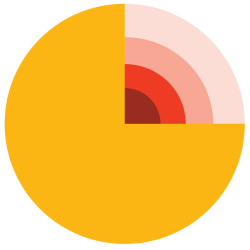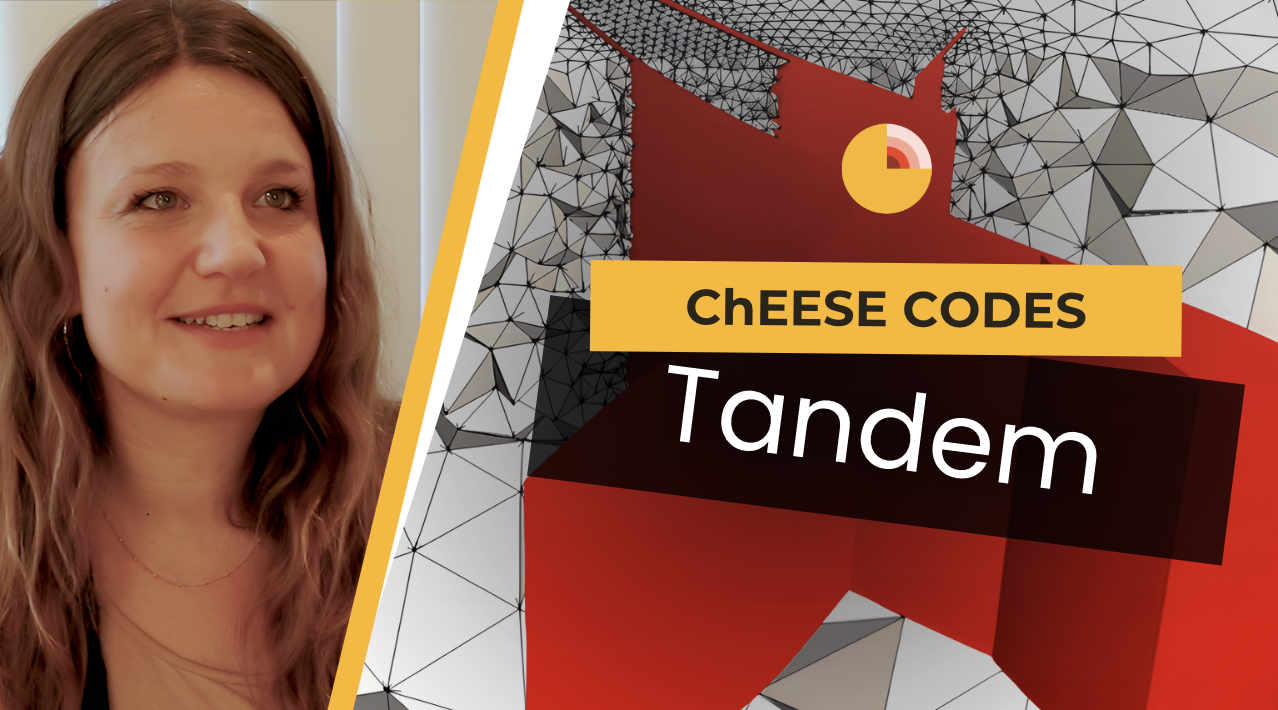Nathalie Favretto-Cristini is actively involved in the ChEESE project as a researcher at the National Centre for Scientific Research (CNRS) in France, an institution collaborating with the project through three laboratories: LMA, IPGP, and ISTerre. Her work primarily focuses on seismic inversion and seismo-acoustic wave propagation in marine environments.
She contributes to simulating complex scenarios like high-resolution seismic tomography and full-wave propagation induced by underwater detonations. Discover more about Nathalie’s role and ChEESE’s scientific challenges in this exclusive interview of the Meet the Researcher series.
What are the main tasks of CNRS in the project?
CNRS has several groups from three laboratories (LMA, IPGP, ISTerre) involved in ChEESE. IPGP and ISTerre study magneto-hydrodynamics and calculate the Earth’s magnetic field from the outer core rotation. My laboratory (LMA) studies seismic inversion, and also seismo-acoustic wave propagation in marine environments.
LMA leads Work Package 5 on the evolution of the flagship codes (Pilot Demonstrators), and co-leads Task 2 of Work Package 6 on Scientific Cases that need exascale capability simulation. We’re involved in two of the four Scientific Grand Challenges that require large-scale pre-exascale execution and involving the SPECFEM code. The first one is led by INGV and aims to obtain high-resolution seismic anisotropic tomography of the Adriatic-Ionian lithosphere. I’m heavily involved in the second one who is led by LMA. The goal is to model, in 3D and up to 100 Hz, the full-wave seismo-acoustic wave propagation induced by the detonation of historical unexploded ordnance (UXO) in the Bay of Hyères (Mediterranean Sea, France), in order to assess both seismic risks and underwater noise pollution.
Reflecting on the past year, what moment stands out as particularly significant for you and the project?
I had already been involved in ChEESE1, so I’m familiar with the “ChEESE” spirit. However, the kick-off meeting of the project was probably the most important moment of the past year, because it was then that I really realized that I was part of a big and fascinating new adventure. It was no longer a project written down on a piece of paper, but a reality. And being together, whether face-to-face or online, was an inspiring moment that gave me strength and even more motivation than I had before.
Can you explain how your work plays a role in hazard assessment?
For some years now, my research has focused on assessing underwater noise pollution and seismic risks generated by anthropogenic activities, as well as their impact on both marine wildlife and coastal buildings. Anthropogenic activities which take place on the seabed, like for instance historical UXO disposal or installation of offshore wind farm foundations, generate high levels of noise (acoustic waves) in the water column and energetic seismic waves of various types which induce seabed vibrations. Since the frequency range of the noise source is wide and very low, generally between 1 and a few hundred Hertz (Hz), acoustic and seismic waves interact in a very complex way, giving rise to seismo-acoustic wave propagation.
To assess risk, we need to understand and reliably model this interaction, according to the geometric and physical properties of the marine environment. To achieve this, wave-physics considerations, development of specific theoretical models, in situ acoustic and seismic experiments, but also numerical modeling of full-wave propagation are required. Due to the broadband frequency content of the noise source, the large dimensions of the marine environment, and the low wave velocities in the seabed, numerical modeling is highly challenging and it is absolutely necessary to rely on HPC resources.
In fact, I have to admit that the supercomputers needed for our targeted purposes (i.e. modeling up to 300 or 500 Hz) do not exist yet. Even exascale machines will not be enough. However, the work we’re doing in ChEESE is crucial, because it prepares the SPECFEM code for the supercomputers of the future, which will be commonplace in a few years’ time. Moreover, by the end of the project we’ll be able to model the full-wave seismo-acoustic wave propagation up to 100 Hz, instead of 30 Hz which was done in ChEESE1. This result will be unique in the underwater acoustics community, and will pave the way for a better assessment of underwater noise pollution and seismic risks.
Are there any particularly challenging aspects or obstacles that you’ve encountered in your research in ChEESE, and how have you overcome them?
As my expertise mainly concerns seismo-acoustic wave physics and theory, as well as experiments, it is very difficult for me to understand all the technical terms related to HPC and the methodologies developed in ChEESE. However, I’m lucky enough to have some incredibly competent guys in my team (Vadim Monteiller, Paul Cristini, Maxence Ferrari) who explain the essential parts to me with great patience. HPC simulations of wave propagation in complex marine environments are not just a question of technique. They also need to be strongly physics-driven, and that is where I come in. I need a minimum knowledge of the specifics of HPC to be able to effectively guide the simulations, i.e. optimize the domain mesh, capture first-order wave phenomena, etc. In my team, we all have complementary skills, which is essential if we are to achieve our scientific goals.
Can you discuss any recent achievements or milestones that your team has reached within the framework of the project?
We’ve succeeded in developing a first portable and modular prototype of the SPECFEM code, which will therefore be easier to use on different machines. This prefigures the future version of the SPECFEM code.
How do you foresee the impact of your research on European society?
Since wildlife relies on sounds for all the critical aspects of survival (i.e. navigation, communication, hunting, finding mates, avoiding predators), the excess of anthropogenic noise can adversely affect marine species, with the potential to cause behavioral and physiological changes, injury, and mortality, and hence impact their ecological role at the biosphere level. If these effects are sufficiently large, they will negatively affect the marine environment and compromise the Good Environmental Status which EU Member States are obliged to maintain. Indeed, in the same way as chemical pollution, anthropogenic underwater noise has been officially acknowledged in the framework of the 2008 Marine Strategy Framework Directive as one of the major sources of pollution for oceans which needs to be effectively addressed. While significant scientific progress has been made for the last decades, knowledge gaps remain, which prevents the development of reliable decision-making tools for calculating noise map scenarios which are representative of different environments and marine species and which are beneficial for policy and decision-makers and practitioners.
My research aims to fill some of these knowledge gaps to better assess anthropogenic noise pollution and provide recommendations for appropriate and proportionate noise mitigation solutions limiting the impact on marine wildlife. As mentioned before, HPC modeling is useful for these purposes. I’m also coordinating a European project on noise pollution, called SEASOUNDS. This is an MSCA Doctoral Network, which started in January 2024 and runs for four years, where experts in underwater acoustics, seismology, mechanics, bioacoustics and marine biology will work closely with the ten PhD students we are currently recruiting. As one of the ten thesis topics is closely related to the work we’re developing in ChEESE, there will automatically be synergy between the two European projects, and this is very exciting!
As a professional who works with mechanics, acoustics, and seismics, what inspired you to pursue this specific area of research, and what excites you most about your work?
In fact, my initial dream was to become an astronaut or launch space rockets. So studying fluid mechanics made sense. During my Master’s degree, I was introduced to acoustics and wave propagation, and it became obvious that I had to pursue this path. Shortly afterwards, I discovered underwater acoustics and chose to do my doctoral thesis in this field. I then decided to broaden my scientific knowledge and accepted a postdoctoral position in a laboratory of geosciences to work in seismic exploration in close collaboration with geophysicists from an oil & gas company. I also worked on seismic monitoring of CO2 storage.
After eleven years, I felt it was time for another change because I was getting a bit bored, which had an impact on my research activity. For the last fifteen years, I’ve been taking advantage of my dual skills in underwater acoustics and seismics to develop research in marine environments. Working on anthropogenic noise pollution and its impact on marine wildlife is fascinating because the topic is very complex and requires a multidisciplinary approach. Working together with experts from different fields is really stimulating! But the most exciting part of my research is undoubtedly its objective: to preserve the marine ecosystem.
What would you be if you were not a researcher?
It’s not an easy question! I’m living the dream of my early adult years, so I can’t imagine doing anything else. However, if I were not a researcher, I’d probably be teaching young children or designing science exhibitions. I think it’s very important to pass on scientific knowledge to young people, as it opens up their minds. And the society really needs people with a good scientific education.
For aspiring scientists or individuals interested in a career in your research area, what advice would you give to inspire and guide them in pursuing this field?
I would say to them: whatever your research area, do what you love and what inspires you. Seize opportunities and be self-confident! Self-confidence is built through action. It doesn’t matter if you fall down sometimes. Learn from your failures, bounce back and move forward. Self-confidence doesn’t mean thinking you’ll succeed at everything, but that you have the inner ability to do things. So “Rêvez en grand”! That means ‘Dream bigexist’, don’t censor yourself. I would also say to them: be persevering and curious. Explore new fields and questions that lie outside your comfort zone. Multidisciplinarity often leads to great scientific achievements, and that’s really fascinating.
Beyond the realm of science, can you share a cultural piece (film, book, podcast) that has significantly influenced your perspective or approach to your work?
Many books have influenced my approach to my work. Of course, biographies of great women scientists such as Marie Curie have inspired me. They showed me that nothing is impossible for a woman in the research world. It’s sometimes hard, but you have to fight.
One film also had a great influence on the choice of my research area: “The Big Blue” directed by Luc Besson. I’m fascinated by freediving and by people who can become one with marine mammals and the ocean. The film’s music, composed by Eric Serra, is truly haunting. It relaxes me a lot and makes me think more clearly.
By Aerton Guimarães
From the ChEESE-2P Dissemination Team



